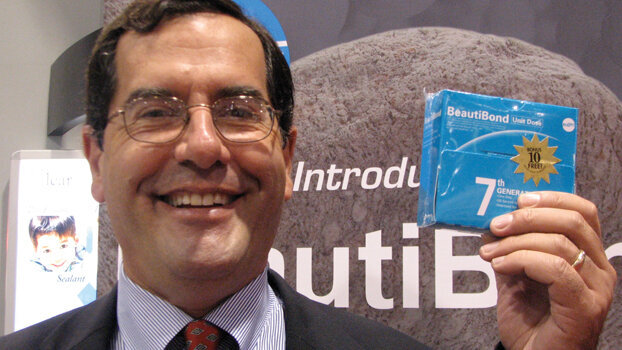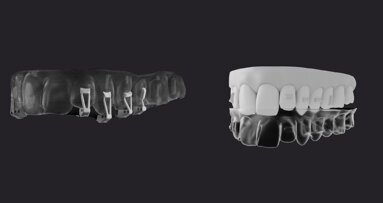ANAHEIM, CA, USA: In an interview with Dental Tribune at the recent California Dental Association meeting (15 to 17 May), C. Brian Melonakos, president and CEO of Shofu, discussed his company’s new BeautiBond seventh-generation bonding agent featuring dual adhesive monomers for dentin and enamel.
What’s so unique about Shofu's new product BeautiBond?
What is really unique about BeautiBond is that there are many dentists who still do not feel confident using seventh-generation bonding agents. This is often related to not having enough confidence that they will remain secure and have a strong enough bond to both enamel and dentin or across all indications.
So, this product, which was designed by our research team in Japan primarily for the American market, is meant to be a single component, very easy-to-use bonding agent that will finally give fourth-, fifth- and sixth-generation users the confidence that they can use this. And the way that happens is they designed two unique adhesive monomers.
One adhesive monomer for dentin and another for enamel, and that is really unique among the seventh generation. They also, in addition to that, developed a unique polymerization catalyst to ensure that you get full cure, full polymerization with the BeautiBond.
One of the other two main features to mention is the fact that it has extremely low film thickness, only 5 microns. For example, the market leader in the bonding category has 40 microns film thickness, so we really feel like that’s an advantage. Another advantage is that we’re hema free. Many of the bonding agents include hema, and over time hema tends to absorb water, which can weaken the bond. And we’re pleased to show that in clinical testing we’ve done that the thermo cycling, at 10,000 cycles, we maintain, if not slightly increase, the bond strength to both enamel and dentin over time. The two monomers are phosphonic acid monomer, which is preferentially bonded to enamel, and carboxylic acid monomer, which is bonded to dentin.
We have a clinical study that’s been going for about a year now, with Dr Mark Latta, who is head of research at Creighton University. This product is being studied in conjunction not only with our own composite, but with competitive materials. We specifically designed this product to be used with all composites, so that’s an important point as well.
How is the product packaged?
It comes in unit doses, which is another advantage because you do not have to worry about evaporation of the material if you leave the bottle open.
You’ve already had some prominent dentists using BeautiBond I believe, is that true?
Yes, of course. There’s Dr George Freedman, who wrote a First Impressions article for Dentistry Today about it. Then there is Jim Dunn, who spoke at the recent AACD (America Association of Cosmetic Dentistry) meeting two weeks ago in Hawaii. Also, a prominent dentist from Japan, Dr Takahashi, who came in and also lectured at the AACD on BeautiBond and on our composite material, which is Beautifil II. Dr Howard Glazer from the New York area has been incorporating this into his lectures for a few months now, and we have a nice video of Dr Glazer and an animation piece that shows the step-by-step technique. These can be viewed on our Web site, so it’s very easy for dentists to familiarize themselves with the technique and procedures involved.
Internal marketing is the most predictable and least expensive form of marketing for dental practices. While there are many types of marketing, ranging from...
Every ortho practice should have clear and challenging performance goals. This is the first step in improving the practice and reaching the office’s ...
Soon after the mass adoption of clear aligners, it became apparent that a plastic shell did not provide sufficient purchase on the teeth for all movements. ...
NEW YORK, N.Y., USA: In an advance toward solving a 50-year-old mystery, scientists are reporting new evidence on how the fluoride in drinking water, ...
In the ever-evolving landscape of dentistry, staying ahead requires embracing innovative technologies that enhance patient care and elevate practice ...
Have you lost the excitement? Are you content with what you might now perceive as the same-old, same-old every day? Day after day you may be performing ...
NEW YORK, NY, USA: A recent public opinion survey commissioned by Oral Health America found that in the past year, more than one-third (35 percent) of those...
NEW YORK, N.Y., USA: If you’ve been to any major dental meeting over the past few years, you’ve no doubt run into him in the exhibit hall. No, ...
Registration is open for the Power of Digital Dentistry Conference, a first-ever conference bringing together Planmeca Romexis, Imaging and CAD/CAM Users. ...
RANCHO MIRAGE, CA, USA: Opalescence was a proud sponsor of the 2011 Mrs. Globe Pageant on Aug. 27, 2011, in Rancho Mirage, Calif., where over 40 delegates ...
Live webinar
Wed. 14 January 2026
12:00 PM EST (New York)
Dr. Théo Laplane, Dr. Robert Gottlander DDS
Live webinar
Fri. 16 January 2026
12:00 PM EST (New York)
Live webinar
Mon. 19 January 2026
1:00 PM EST (New York)
Philipp Kopp, Michael Seeber
Live webinar
Thu. 22 January 2026
9:00 AM EST (New York)
Prof. Judith Jones D.D.S; M.P.H., Prof. Kakuhiro Fukai D.D.S., Ph.D, Dr. Bathsheba (Bethy) Turton
Live webinar
Thu. 22 January 2026
2:00 PM EST (New York)
Dr. Nicola M. Grande DDS, PhD
Live webinar
Wed. 28 January 2026
8:00 AM EST (New York)
Live webinar
Wed. 28 January 2026
11:00 AM EST (New York)
Prof. Dr. Jan-Frederik Güth



 Austria / Österreich
Austria / Österreich
 Bosnia and Herzegovina / Босна и Херцеговина
Bosnia and Herzegovina / Босна и Херцеговина
 Bulgaria / България
Bulgaria / България
 Croatia / Hrvatska
Croatia / Hrvatska
 Czech Republic & Slovakia / Česká republika & Slovensko
Czech Republic & Slovakia / Česká republika & Slovensko
 France / France
France / France
 Germany / Deutschland
Germany / Deutschland
 Greece / ΕΛΛΑΔΑ
Greece / ΕΛΛΑΔΑ
 Hungary / Hungary
Hungary / Hungary
 Italy / Italia
Italy / Italia
 Netherlands / Nederland
Netherlands / Nederland
 Nordic / Nordic
Nordic / Nordic
 Poland / Polska
Poland / Polska
 Portugal / Portugal
Portugal / Portugal
 Romania & Moldova / România & Moldova
Romania & Moldova / România & Moldova
 Slovenia / Slovenija
Slovenia / Slovenija
 Serbia & Montenegro / Србија и Црна Гора
Serbia & Montenegro / Србија и Црна Гора
 Spain / España
Spain / España
 Switzerland / Schweiz
Switzerland / Schweiz
 Turkey / Türkiye
Turkey / Türkiye
 UK & Ireland / UK & Ireland
UK & Ireland / UK & Ireland
 International / International
International / International
 Brazil / Brasil
Brazil / Brasil
 Canada / Canada
Canada / Canada
 Latin America / Latinoamérica
Latin America / Latinoamérica
 China / 中国
China / 中国
 India / भारत गणराज्य
India / भारत गणराज्य
 Pakistan / Pākistān
Pakistan / Pākistān
 Vietnam / Việt Nam
Vietnam / Việt Nam
 ASEAN / ASEAN
ASEAN / ASEAN
 Israel / מְדִינַת יִשְׂרָאֵל
Israel / מְדִינַת יִשְׂרָאֵל
 Algeria, Morocco & Tunisia / الجزائر والمغرب وتونس
Algeria, Morocco & Tunisia / الجزائر والمغرب وتونس
 Middle East / Middle East
Middle East / Middle East





























































To post a reply please login or register